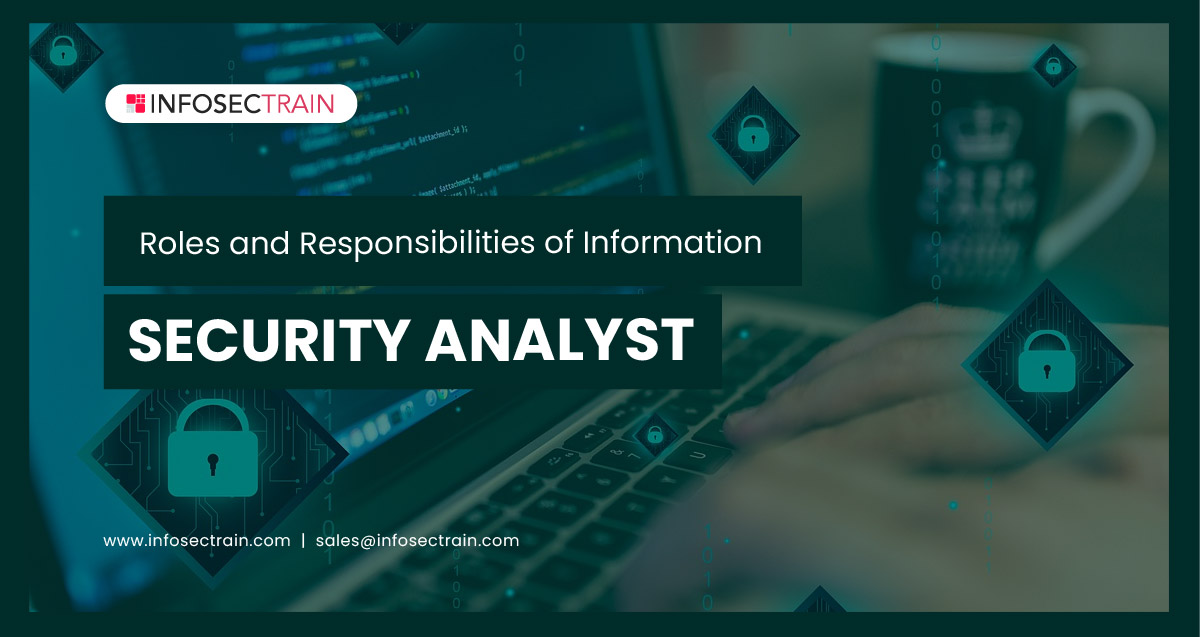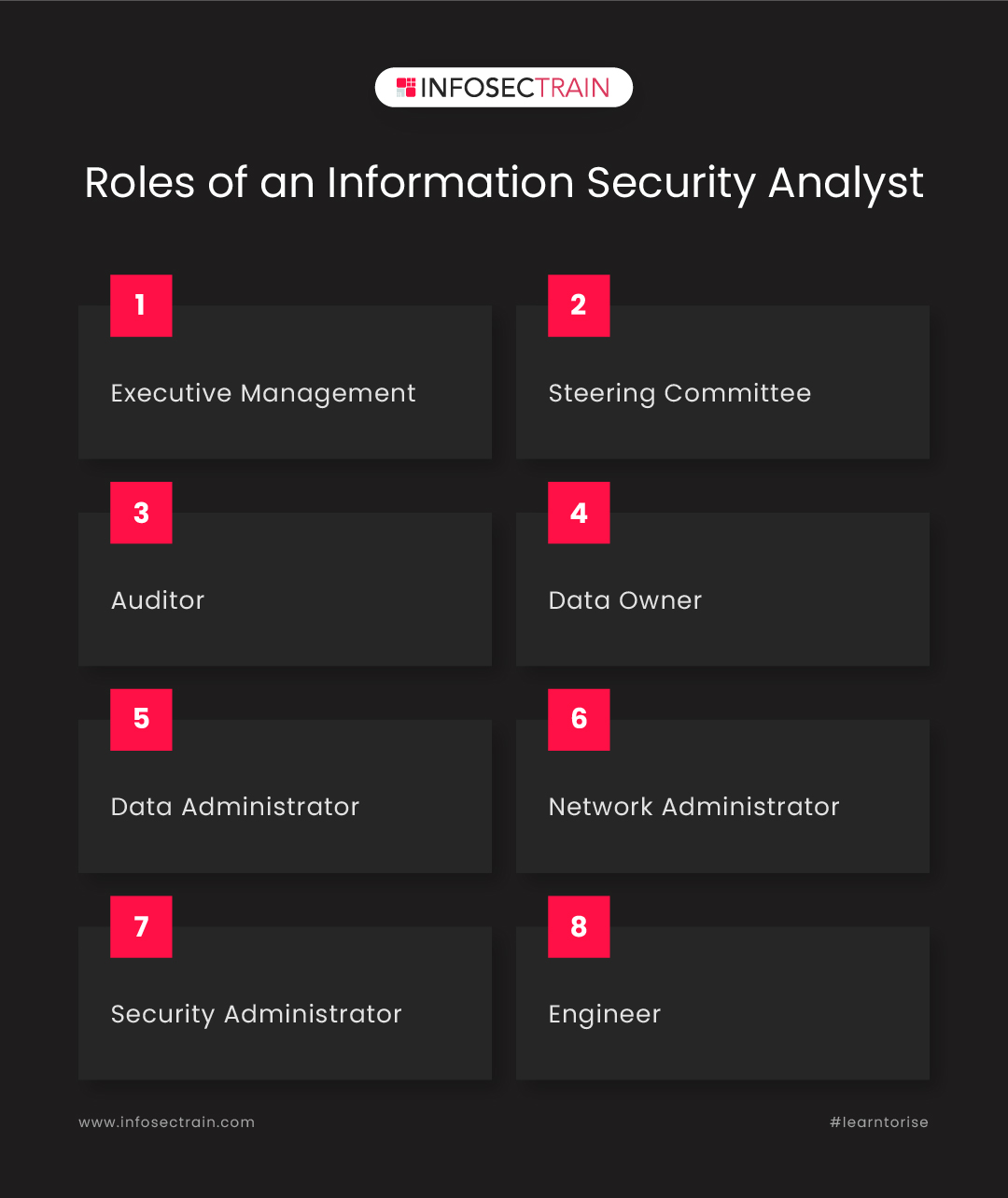Roles and Responsibilities of Information Security Analyst
Cyber-attacks and data breaches are becoming a significant concern for all businesses in recent years. Therefore, information security is a critical component of every company’s success. Organizations have shifted to cybersecurity experts who can apply their expertise and best practices to protect their assets. As a result of this, the demand for Information Security Analysts is booming. These specialists are regarded as the foundation of enterprise security because they protect essential data from unauthorized access.
Table of Contents
Who is an Information Security Analyst?
Roles of an Information Security Analyst
Responsibilities of an Information Security Analyst

Who is an Information Security Analyst?
Information Security Analysts protect their companies’ data by designing and implementing cyberattack prevention and mitigation strategies. Because of the nature of their line of work, these individuals play an important role in the public, commercial, and non-profit sectors, as they safeguard an organization’s confidential and essential information.
According to Cisco, a cyberattack is a malicious or legitimate attempt to penetrate an organization’s or individual’s information system. These cyberattacks can come in many different forms, including ransomware, phishing scams, and others, and the consequences can be disastrous. It is the responsibility of Information Security Analysts to prevent such cyberattacks and mitigate the harm if an attack happens.
Roles of an Information Security Analyst
As per the Bureau of Labor and Statistics (BLS), an Information Security Analyst is in charge of developing and implementing security measures to secure a company’s information systems and networks. Standard Information Security Analyst job roles fall into the following categories:

- Executive Management: The information security strategy of a corporation is decided by the executive-level leaders. They analyze cyber risk, review security data and reports, and make choices on information security strategies and funding.
- Steering Committee: Professionals from various departments usually make up a steering committee. Members of the committee examine cybersecurity policies and processes, as well as their impact, and look for methods to improve the organization’s security infrastructure.
- Auditor: An information security strategy is audited by a third-party expert or authority auditing an information security strategy. This individual is not involved in the day-to-day functioning of the organization. This enables them to provide an unbiased assessment of the organization’s cybersecurity strategy and recommendations for improvement.
- Data Owner: The classification of data has far-reaching implications for information security. The Data Owner is in charge of determining how data is classified, handled, and secured, which is crucial to the organization’s information security measures.
- Data Administrator: A Data Administrator is in charge of information storage and transformation. The Data Administrator controls the technical environment and data structures associated with data, providing that it is safe and available to authenticate users.
- Network Administrator: A Network Administrator assures that assets are accessible to all stakeholders in an organization and maintains security systems.
- Security Administrator: Security Administrators examine an organization’s overall security and its ability to defend itself from security breaches. They normally implement security access controls, but they are not required to update them.
- Engineer: Engineers of three categories can help with a company’s information security planning:
- Network Security Engineer
- Software Security Engineer
- Security Appliance Engineer
These Engineers collaborate to develop secure software and IT infrastructures that keep cybercriminals away.
Responsibilities of an Information Security Analyst
Information Security Analyst jobs come with a lot of responsibilities. These can be classified into the following groups:
- Access Control: Access controls, which determine who has access to data and systems within the organization, are the responsibility of Information Security Analysts. To properly conduct their daily responsibilities, these professionals must establish who needs access to data and systems.
- Network and Application Performance: Check the performance of the networks and applications of the organization. This enables security concerns that restrict application or network performance to be immediately discovered and resolved before creating outages or service disruptions.
- Software Maintenance: They must update the softwares on a regular basis to guarantee that organizational systems operate at peak efficiency and are protected from new cyber threats.
- Vulnerability Assessment: Security flaws might appear at any time and must be handled immediately. Vulnerability assessment enables your organization to detect and address vulnerabilities by executing predefined policies and protocols.
- Endpoint Detection and Response: Endpoint and network events are continuously monitored as part of endpoint detection and response. Internal and external threats, such as malware, ransomware, and other advanced cyberattacks, can be monitored and reported using endpoint detection and response solutions.
- Backup and Disaster Recovery: The system of the organization is facilitated by backup and disaster recovery. It entails backing up data and systems and assuring that they can be retrieved quickly in the event of a security breach.
Information Security Analyst with InfosecTrain
Since training increases your understanding and strengthens your foundations in any field, selecting the correct training provider is important. At InfosecTrain, we offer extremely knowledgeable trainers with extensive experience in a variety of areas. We are a leading training organization with a worldwide reputation. Enroll in InfosecTrain’s Information Security Analyst or other career-oriented certification training courses to start your preparations.






 1800-843-7890 (India)
1800-843-7890 (India) 
